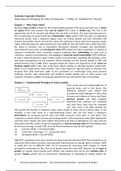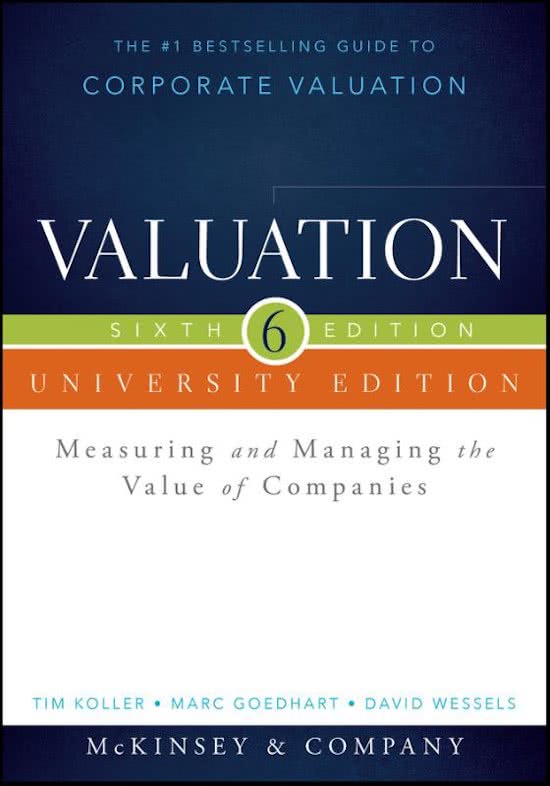Summary Corporate Valuation
Measuring and Managing the Value of Companies – T. Koller, M. Goedhard & D. Wessels
Chapter 1 – Why Value Value?
Business value creation is based on the simple guiding principle, firms grow and must earn a return
on capital (ROC) that exceeds their cost of capital (COC) value or hurdle rate. The COC is the
opportunity cost for its investors and reflects the risk of the cash flows. The most important goal of a
firm is maximizing its current and future shareholders’ value, which is NOT the same as maximizing
short-term profits. Only a long-term organic focus on revenue growth and R&D innovation will
increase shareholder returns and intrinsic value. Any attempts to boost short-term earnings results
makes achieving long-term value growth even more difficult. This short-term focus could come from
the board or investors. Due to asymmetric information between managers and shareholders,
maximizing the share price and earnings per share (EPS) needs to be done sustainably. A creation of
long-term shareholder value sometimes requires satisfying other stakeholders as well, such as
customers, suppliers and employees; and engaging in corporate social-responsibility (CSP) initiatives.
In such a trade-off long-term value creation needs to be prioritized, forgetting this principle comes
with great consequences for the economy. Recent examples are the Internet bubble in 2002 and
global Financial crisis in 2008. Many managers forgot the drivers and importance of the return on
invested capital (ROIC) ratio, they could worry about creating an effective business model later.
Banks in turn forgot about value creation, they issues long-term high-risk loans to investors that
financed them with short-term debt. As the assumption on continuingly rising prices became
irrational, security value plummeted and problems quickly spoiled over to other sectors and
countries. A bubble or crisis is the huge gap between the true and market value of something.
Chapter 2 – Fundamental Principles of Value Creation
Firms create value by investing cash now to
generate more cash in the future, the
difference between cash inflows and
investments made adjusted for time value
of money and riskiness of future cash flows.
Revenue growth and ROIC together
determine how revenues are converted
into cash flows, both must be sustained
over time. Only if the ROIC exceeds the
COC growth will increase a company’s value, faster growth at lower returns reduces value. In this
situation, a firm must invest at a value-destroying return. One can only assess a company’s
performance by comparing growth rates and ROIC measures across time or with peers. Two
companies can show similar revenue and earnings growth, while investment ratios differ significantly
such that value creation also varies (higher discounted cash flows at appropriate COC rates with the
same level of profits). Value can also be expressed as a price-to-earnings ratio (P/E) by dividing value
by first-year earnings. Growth, ROIC and cash flows (investment rate) are tied together:
(1) Growth=ROIC × Investment Rate
(2) Cash Flow=Earnings ×(1−Investment Rate)
(3) Investment Rate=Growth/ ROIC
High-ROIC companies create more value by focusing on growth and lower ROIC-firms should focus on
improving returns before growing. Assuming both improvements are equally likely to achieve, while
in reality this can be different. ROIC can be increased by improving profit margins or capital
productivity, preferably the first. But not all growth earns the same ROIC, likewise not all types of
growth are equally value-creating. Each industry and company type has its own pecking order of
growth. Organic growth such as new-product development or expanding an existing market are
1
Summary Corporate Valuation – Vrije Universiteit Amsterdam – Annamarie de Ruijter
,often the most rewarding, because they don’t require much new capital. Inorganic growth like
mergers and acquisitions (M&A) creates least value most of the times, due to the high investment
requirements up front. One can also measure value creation by economic profit, it encourages firms
to undertake investments that earn more than their COC even if this return is lower than the current
average return:
(4) Economic Profit=Invested Capital×( ROIC −COC)
The key driver formula with its inputs captures the essence of valuation. Net operating profit less
adjusted taxes (NOPLAT) is profits after subtracting income taxes related to operations. Invested
capital is the amount a firm uses to operate its cash generating assets. Mainly property, plant and
equipment (PPE) and working capital. Net investment (NI) is the increase in invested capital from
one year to the next. Free cash flow (FCF) is the cash flow generated from operations after deducting
investments in new capital. ROIC is the return a company earns on each dollar invested in the
business. The investment rate (IR) is the portion of NOPLAT invested back into the business. The
weighted average cost of capital (WACC) is the rate of return that investors expect from investing in
the company and the appropriate discount rate for the FCF. Growth (g) is the rate at which the
company’s NOPLAT and cash flow grow each year.
(5) ¿=Invested Capital t+1 −Invested Capital t
(6) FCF=NOPLAT −¿ or FCF=NOPLAT ×(1−IR)
(7) ROIC=NOPLAT / Invested capital
(8) IR=¿/ NOPLAT
(9) g=ROIC × IR
(10) Value=FCF t =1 /WACC −g or Value=FCF t =1 × ¿¿
The key value driver formula is based on a perpetuity assumption or constant growth until infinity.
Often, a terminal value term is added at the end to capture the firm in its mature situation after high
growth. Higher cash flows and growth rates lead to more value, while a higher COC reduces value
(cetrus paribus) but these relations can sometimes play both ways. This methodology is similar to the
discounted cash flow (DCF) method, which values assets based on their cash flows, growth and risk.
The output or intrinsic value is often not the final value due to many uncertainties or noise in the
input values and possibilities for manipulation, but the process of understanding the firm
characteristics is important.
Chapter 3 – Conservation of Value and the Role of Risk
The conservation of value implies that anything that doesn’t increase cash flows doesn’t create
value, it’s just conserved or unchanged. For instance, changing the ownership structure by debt for
equity or appearance of cash flows by using other accounting techniques. This only alters or betters
financial statements and reported results, researched and supported by Modigliani & Miller (1958) in
their irrelevance theory. Company value doesn’t change by changing capital structure, unless cash
flows also change through tax deductions or changes in management decisions. Close lies the
definition of an efficient market, one that isn’t fooled by actions that don’t affect cash flow.
The conservation principle applies to many decisions such as share repurchases, acquisitions and
financial engineering. A share repurchase has become a popular way besides dividends to return
cash to investors if managers believe the share price is undervalued, it increases EPS and other return
ratios but leaves cash flows unchanged. Unless managers would otherwise invested cash unwisely,
share repurchases in themselves don’t create value. Acquisitions only create value if the combined
cash flows of the two companies and thus performance increases due to cost reductions, faster
revenue growth or better use of (fixed or working) capital. Financial engineering is the use of
financial instruments or structures other than straight debt and equity to manage a company’s
capital structure and risk profile. Examples are derivatives, convertible debt, securitization or off-
2
Summary Corporate Valuation – Vrije Universiteit Amsterdam – Annamarie de Ruijter
, balance-sheet financing such as sale-leaseback. Most of these don’t create value due to its short-
term impact, only tax benefits from separating ownership and operation increases cash flows.
Future cash flows are unknown and risky. Risk is expressed in the COC or price charged by investors
for bearing the risk that the firm’s future cash flows may differ from what they anticipate when the
investment is made, thus the opportunity cost of an investment with equal risk. It’s used for
discounting when calculating the present value or today’s value of an investment, splitted in the cost
of equity and debt. To decrease the variation in COC or risk, investors diversify their portfolio or
invest in multiple stocks and companies. Total risk declines as more shares are added to the portfolio,
because companies’ cash flows aren’t correlated captured by firm-specific or idiosyncratic risk.
Investors only require compensation for risk that they can’t diversify away, which is market or
systematic risk such as exposure to economic cycles. These latter risk factors are often not taken into
account when calculating the COC, managers only worry about the uncertainty about future cash
flows. While the added risk premiums are sometimes arbitrary, firms should only hedge risk that they
can control and shareholders can’t manage for themselves.
Chapter 4 – The Alchemy of Stock Market Performance
The total return to shareholder (TRS) measures the amount shareholders gain through stock price
appreciation plus dividends and is often used to assess firm and management performance. It needs
to be measured over a minimum period of 10 to 15 years, because TRS is harder to improve in the
mature successful stage and it often doesn’t show how improvements in operating performance
contribute. Different investors earn various returns compared to the company’s ROC, because they
pay different prices for the shares based on their expectations of future firm performance. Low
expectations are easier to beat, while high expectations and increasing share prices lead to faster
running managers. Improving the TRS and outperforming the stock market varies per firm and
situation, high performance is
sometimes already incorporated in
the share price such that even with
outperformance share prices and
TRS will equal the peer average.
This could imply a mismatch
between TRS and value created or
performance judged by investors.
Decomposing TRS can lead to a
better understanding of this
mismatch and setting future
realistic targets.
The TRS is decomposed as follows:
(11) TRS=Percent Change Share Price+ Dividend Yield
(12) TRS=Percent Increase Earnings+ Percent Change P /E + Dividend Yield
(13) Percent Incrase Earnings=Percent Increase Revenues + Percent Increase Profit Margin
(14) Share Price =Earnings× P /E
(15) Dividends=Earnings ׿
(16) Dividend Yield=E/ P−g /ROIC × E /P
(17)
TRS=Percent Increase Revenue + Percent Change Profit Margin + Percent Change P/ E+ E /P−¿
Earnings over price (E/P) is the inverse of the price-to-earnings ratio. It’s the return an investor
would earn if the firm didn’t grow or improve its profit margin and paid out all earnings in dividends
(constant share price). The last term is the required reinvestment each year to achieve its growth at
its level or ROIC.
3
Summary Corporate Valuation – Vrije Universiteit Amsterdam – Annamarie de Ruijter






